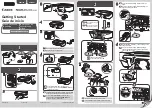
Before you begin
If roll media is not correctly loaded, banding that looks like under/over stepping can result.
If a media shows significant tension deviation across its width, or if it telescopes signifi-
cantly (identifiable by the edges of the media on the Take-up roll), it is difficult to accu-
rately find the correct MACF. If the media telescopes, reload it before you start the cor-
rection procedure. One tell-tale indicator of telescoping and significantly varying tension
is to look at the Media Advance Correction Print near the sides; if under stepping banding
occurs on one side, and overstepping on the other, the banding is not the result of an
incorrect correction factor, rather it is possibly due to an improper media load.
How You Determine the MACF
In the 'Roll Media Manager' menu you can select the 'Media Advance Correction Factor'
(MACF) and enter a value from 0 to 100. The default value is 50. You can enter a lower
value to correct for white gaps or raise the value to correct for dark lines.
To arrive at the MACF for a given media, a Special Print is used. The print images a series
of colors that are used to identify a range where no white gaps or overlap (dark lines) are
evident. Depending on the given media, some of the colors may be more susceptible than
others to this banding (this is why more than one color is present on the test print). The
test print used for the calibration of the MACF can be found in the Special Prints module.
It is called the Media Advance Correction Factor print.
Procedure to Determine the MACF for Upper Limit Value
1.
Click the Roll Media icon to bring up the Roll Media Manager.
2.
Enter a large value for the media advance correction factor, (say 75) and print the image.
Verify that white gaps are present (spaced a swath width apart); if they aren't, enter a
larger value and reprint (continue until the white gaps are noticeable).
3.
Once gaps are verified, reduce the correction factor value by 10 or 5 and reprint. Continue
reducing the value and reprinting the test image until white gaps are no longer visible.
At this point fine-tuning can be done if desired, changing the correction factor by values
of around 2 or 3 to determine the exact spot banding occurs; this level of accuracy usually
isn't necessary. Record this value as the high end of your MACF range.
Procedure to Determine the MACF for Lower Limit Value
1.
Enter a low media correction value (say 15), and verify that noticeable understepping
occurs, in the form of dark lines spaced a swath width apart.
2.
Once understepping swaths have been verified, increase the media correction value by
10 or 5, stopping when you no longer see dark lines (Again, finding the exact value where
Chapter 6 - How to Operate the Roll Media Option
130
How to Determine Media Advance Correction
Summary of Contents for Arizona 550 GT
Page 1: ...Océ Arizona 550 GT User Manual Version 1 0 Revision B Océ User Manual ...
Page 6: ...6 Contents ...
Page 7: ...Chapter 1 Introduction ...
Page 15: ...Chapter 2 Product Overview ...
Page 19: ...Chapter 3 Safety Information ...
Page 43: ...Chapter 4 How to Navigate the User Interface ...
Page 71: ...Chapter 5 How to Operate the Océ Arizona 550 GT ...
Page 101: ...Chapter 6 How to Operate the Roll Media Option ...
Page 135: ...Chapter 7 How to Use the Static Suppression Upgrade Kit ...
Page 139: ...Chapter 8 How to Work With White Ink ...
Page 179: ... 145 Parameters Chapter 8 How to Work With White Ink 179 How to Use Media Models ...
Page 196: ...Chapter 8 How to Work With White Ink 196 How to Create and Use Quick Sets ...
Page 197: ...Chapter 9 Ink System Management ...
Page 205: ...Chapter 10 Error Handling and Trou bleshooting ...
Page 209: ...Chapter 11 Printer Maintenance ...
















































